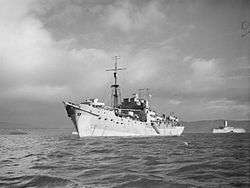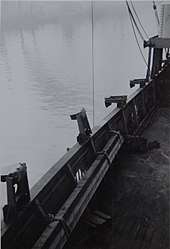HMS Largs
HMS Largs was a former Compagnie Generale Transatlantique (French Line)[1] fruit (banana) ship captured by the Royal Navy ship HMS Faulknor[2] five months after the Battle of France while docked at Gibraltar in November 1940 and commissioned as an "ocean boarding vessel". She subsequently became a Combined Operations Headquarters ship for almost every significant amphibious operation of World War II, including Operations Torch, Husky and Overlord and she would be manned by naval, army and air force crew.[3]
 HMS Largs at Greenock | |
| History | |
|---|---|
| Name: | MV Charles Plumier |
| Owner: | Compagnie Générale Transatlantique (The French Line) |
| Builder: | Chantiers & Ateliers de Provence at Port de Bouc |
| Commissioned: | 1938 |
| Captured: | by Royal Navy November 1941 |
| Name: | HMS Largs |
| Acquired: | November 1941 |
| Decommissioned: | 1945 |
| Fate: | Returned to France |
| Commissioned: | 1945 |
| Decommissioned: | 1964 |
| Fate: | Sold to Greek Cruise company |
| Name: | MV Pleias |
| Commissioned: | 1964 |
| Decommissioned: | 1968 |
| Fate: | Scrapped 1968 |
| General characteristics | |
| Class and type: | cargo-passenger ship |
| Tonnage: | 4,626 tons GRT |
| Length: | 104,45 m |
| Beam: | 15,8 m |
| Draught: | deadweight 2386 tons |
| Propulsion: | 2 propellers, 2-stroke MAN-Diesel engines, 5200HP |
| Speed: | 14,5 Knots |
Royal Navy Transfer
She was built by France and named MV Charles Plumier[2] in 1938. Following the creation of Vichy France and Free France she was transferred in 1941 to the Royal Navy, instead of being handed over to the Free French Navy, and renamed HMS Largs. She took part in many operations including Operation Torch, the invasion of North Africa, and Operation Overlord, during the invasion of Normandy.[4] she was the headquarters ship for Sword Beach.[5]
Camouflage research

HMS Largs was used in 1942 for secret trials of a Canadian invention, diffused lighting camouflage. This used dimmable lamps for counter-illumination, camouflage by bringing the brightness of the ship's superstructure to the same as the night sky. The system of 60 lamps reduced the distance at which a ship could be seen from a surfaced submarine by 25% using binoculars, or by 33% using the naked eye. It worked best on clear moonless nights, at best preventing Largs from being seen until it closed to 2,250 yards (2,060 m) when counter-illuminated, compared to 5,250 yards (4,800 m) unlighted, a 57% reduction in range. However, with the development of marine radar, the system was not put into service.[7]
Pacific & Post WWII
In 1945 she was transferred to the Pacific War and used in actions off Thailand and Malaya. After the end of the war she was handed back to France, and served for nineteen years. She was sold off to a private company from Greece in 1964 as a cruise ship, and given the name MV Pleias. She was scrapped in 1968.
References
- "French Lines cargo ship CHARLES-PLUMIER". Archived from the original on 24 October 2007. Retrieved 5 January 2015.
- "A 6944". www.iwm.org.uk. Retrieved 15 December 2012.
- "Normandy: Combined Operations". www.bbc.co.uk. Retrieved 15 December 2012.
- "Memories of D-Day: Naval Memories". www.ddaymuseum.co.uk. Retrieved 15 December 2012.
- "HMS Largs". www.bbc.co.uk. Retrieved 15 December 2012.
- Admiralty (1942). Trial Report D.L. 126: DL Trials on HMS Largs in Clyde Approaches. ADM/116/5026 Diffused Lighting. The National Archives, Kew: Admiralty.